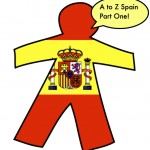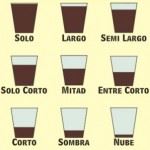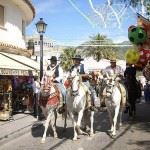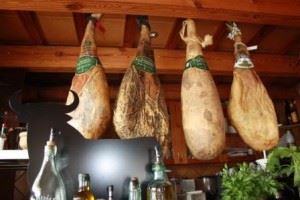
A to Z Spain: (Part One)
Welcome to our very first A to Z Spain. In future posts we will focus on more specific topics but for this first A to Z Spain we would like to share some general insights into the country we have chosen to make our home.
We hope to provide you with some interesting facts, dispel a few myths and touch on a few delicate issues.
Here we go with A to M ...
A is for Architecture: Despite what we may lead you to believe, Spain is not all about beaches! It boast some amazing architecture, in places such as Barcelona, Granada, Cordoba, La Coruña, Seville, Valencia to name just a few ... Because of their artistic relevance, many architectural sites in Spain, and even portions of cities, have been designated World Heritage sites by UNESCO. Did you know that Spain has the second highest number of World Heritage Sites in the world? See the full list here A friend of ours , Molly, has visited quite a few of them ...Read her comments here: UNESCO Sites I´ve seen in Spain – 8 and a half?
B is for Bullfighting: At the time of writing this, bullfighting continues to be a controversial subject and a matter which divides many people. Once considered an honored and patriotic, Spanish tradition, bullfighting is becoming a bone of contention in many areas of Spain. Bullfighting was banned in the Spanish autonomous community of Catalonia by a vote of the Catalan Parliament in July 2010. The ban came into effect on 1 January 2012. The last bullfight in the region took place in Barcelona in September 2011. The ban, which ended a centuries-old tradition in the region, was supported by animal rights activists but opposed by some, who saw it as motivated by political nationalism rather than animal welfare. There is a movement to revoke the ban in the Spanish congress, citing the value of bullfighting as "cultural heritage." The proposal is backed by the majority of parlamentarians. Read more via Wikipedia HERE
C is for Coffee: We love Spanish coffee. Spanish coffees should never be served in a paper cup nor from a filter pot. Ordering coffee in Spain is an art. Each area has its own interpretations of the mixture. Read more about How to Order Coffee in Spain HERE.
Spain is an art. Each area has its own interpretations of the mixture. Read more about How to Order Coffee in Spain HERE.
D is for Driving: Be warned that, in Spain, indicators are optional extras. Double parking is the norm, especially if you need a quick chat with a passing friend. Whenever possible avoid taking the middle lane around a roundabout, even if taking the 3rd exit. You may be there for a long time ... On a more serious note, the Spanish traffic police are quick to issue fines and non payment of fines can become a very expensive experience, for residents and tourists alike. Read more about driving in Spain HERE.
E is for Education: When you come into Spain you are faced with an option about what sort of education you are going to give your child. There are primarily four options: homeschooling (which is currently illegal in Spain), state school, private and concertado. We often hear people criticise the Spanish style of "rote learning". However, we have been very happy with our own experience so far. Read more about education in Spain here. For further information about education in Spain, visit www.bestschoolsabroad.com , a new website we are working on with Graham from Valencia amongst others.
F is for Festivos: More commonly known as bank holidays in English. Be warned that there are loads of them and no matter how many calendars you check, you will get caught out one day! Not only do we enjoy national holidays, every city, town and village have their own excuses for a festivo. ¡Vive la Feria!
G is for Guiri: The term "guiri" is street slang used to describe the what is considered to be the stereotypical tourist or foreigner from Northern Europe. Although generally considered a friendly term, even a term of endearment, it can be a slight mocking that you’ll hear from anyone who’s picked up on something particularly un-Spanish about you. Some people are offended by this name, and go out of their way to avoid being called a guiri by their Spanish friends. If you are one of these people, you may want to read this amusing article on The Local “How not to blow your cover as a guiri”

- Strolling around the Mijas feria ...
H is for Horses: Horses, of all breeds and backgrounds, are a prominent feature in Spanish daily life in many parts of Spain. For us, there is still something magical about seeing a horse trotting through our local village, Mijas pueblo, or down the main road towards Fuengirola and of course, dressed up to the nines when it's feria time. The sight of Spanish horses and their riders, (usually beautifully dressed in traditional costume), stood at a bar, having a drink, always puts a smile on our face. For some more information about the PRE Horses (purebreed spanish horses) read this great guest post by Manni from Toma Tours : An article about Spanish Horses.
I is for Islands: Aside form the Spanish mainland, Ceuta and Melia (in Africa!), Spain is also made up of the Balearic Islands (Mallorca, Menorca, Ibiza and Formentera) and the Canary Islands (Tenerife, Gran Canaria, Fuerteventura, Lanzarote, La Palma, La Gomera, El Hierro, La Graciosa and Isla de Lobos). We will not venture in to the debate about Gibraltar at this point!
Some great websites and blogs about the Spanish islands can be found here: Sunshine Guide to Gran Canaria , MatthewHirtes.com , Lanzarote Information , La Palma Island .
J is for Jamon: Jamon Serrano, Jamon Iberico ... Spanish cured ham. Whatever you want to call it, it is simply delicious! A local delicacy and a common starter or tapa in most parts of Spain. (By the way, can you spot which of the ones in this picture is not a Spanish Jamon?)

K is for King Juan Carlos: Juan Carlos I is the current King of Spain. General Francisco Franco named Juan Carlos as the next head of state in 1969. He became King on 22 November 1975, two days after General Francisco Franco's death, the first reigning monarch since 1931. Despite most members of the Spanish Royal family enjoying favorable popularity, King Juan Carlos has received an unusual amount of publicity over the last couple of years and not without reason. If you’d like to read more, have a look at this tongue in cheek article in The Guardian “King Juan Carlos of Spain: a man of sacrifice”
L is for Language : Not everyone speaks Spanish in Spain. Although Spanish (Castilian) is the official language of the whole country, there are several regional languages: Aranese, Basque, Catalan and Galician, which have co-official status in their respective communities (except Aranes) and are widespread enough to have daily newspapers and significant book publishing and media presence
In the cases of Catalan and Galician, they are the main languages used by the Catalan and Galician regional governments and local administrations. A number of citizens in these areas consider their regional language as their primary language and Spanish as secondary. The use of Catalan is a hot topic as we write this, partly due to the ongoing fight for independence. For an insight into this subject, read Simon Harris’s post HERE.
M is for Menu del Día: Simply the best value for money food you will find anywhere in Spain! A Menu del Día normally includes; a choice of starters such as soup, pasta or salad; plus a choice of main courses such as fish, meat, chicken; plus a selection of desserts or coffee. In some establishments a drink is also included, all for one fixed price. It’s a great way to taste what the locals are eating and it will probably include dishes that you would not have ordered if left on your own. For a great article about Menu del Dia, read Gabriella’s post HERE.
So, there you have Part One of our A to Z Spain: Things we think you should know about Spain... We hope you found it interesting and would love to read your comments and insights.
To read N to Z: Part Two, Click Here.
By Lisa Sadleir